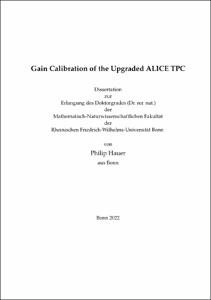Hauer, Philip: Gain Calibration of the Upgraded ALICE TPC. - Bonn, 2022. - Dissertation, Rheinische Friedrich-Wilhelms-Universität Bonn.
Online-Ausgabe in bonndoc: https://nbn-resolving.org/urn:nbn:de:hbz:5-68749
Online-Ausgabe in bonndoc: https://nbn-resolving.org/urn:nbn:de:hbz:5-68749
@phdthesis{handle:20.500.11811/10464,
urn: https://nbn-resolving.org/urn:nbn:de:hbz:5-68749,
author = {{Philip Hauer}},
title = {Gain Calibration of the Upgraded ALICE TPC},
school = {Rheinische Friedrich-Wilhelms-Universität Bonn},
year = 2022,
month = nov,
note = {For the upcoming Run 3 of the LHC at CERN, the interaction rate of lead-lead collisions will be increased to 50kHz . Especially for the main detector of the ALICE experiment, the TPC, this is a major challenge, as its previous readout rate was limited to a few 100Hz. The two main reasons for this limitation were the gas amplification stage and the used readout electronics. Therefore, the gas amplification stage, which was based on a multi-wire proportional chamber, was exchanged with a GEM-based amplification stage. In addition, the readout electronics were also exchanged. With this upgraded setup, a trigger-less operation of the TPC becomes possible, resulting in a continuous readout without dead time. It is therefore well suited to operate at lead-lead interaction rates of 50kHz.
One of the main goals of this work is the calibration of the effective gain of the upgraded ALICE TPC. For this, two different methods were used. The first one is based on an X-ray tube which irradiates the active volume of the TPC, the second one on the gaseous and radioactive isotope 83mKr, which is injected into the TPC. With the results of these measurements, a coarse gain equalisation could be performed, during which the electric potentials of the GEM stacks were adjusted such that the average gain was equalised. In a further analysis, the relative effective gain for each of the 524160 readout channels was determined in an iterative process. This information is needed to correct software-wise for the static variations of the effective gain (e.g. due to variations of the hole sizes in a GEM foil). After applying this calibration to measured data, one can quantify key parameters of the detector, for example the energy resolution. Furthermore, it is possible to calibrate dynamic variations of the effective gain, which are caused for example by variations of temperature and pressure or by the electrostatic charging-up of the GEM foils.
Understanding the latter effect is the second main goal of this work. In order to analyse the charging-up effect in GEM foils, two approaches were pursued. The first one is an iterative simulation of the effect with the usage of the framework Garfield++, in which electrons and ions can be tracked microscopically. The measurements of the charging-up effect with a dedicated detector is the second approach. Three different measurement methods were used to quantify the charging-up effect. The first one is based on the measurement of electric currents which are induced on the readout plane. The second one relies on the measurement of 55Fe spectra with a single GEM, while in the third measurement method, a second amplification stage, a MicroMegas, was added.},
url = {https://hdl.handle.net/20.500.11811/10464}
}
urn: https://nbn-resolving.org/urn:nbn:de:hbz:5-68749,
author = {{Philip Hauer}},
title = {Gain Calibration of the Upgraded ALICE TPC},
school = {Rheinische Friedrich-Wilhelms-Universität Bonn},
year = 2022,
month = nov,
note = {For the upcoming Run 3 of the LHC at CERN, the interaction rate of lead-lead collisions will be increased to 50kHz . Especially for the main detector of the ALICE experiment, the TPC, this is a major challenge, as its previous readout rate was limited to a few 100Hz. The two main reasons for this limitation were the gas amplification stage and the used readout electronics. Therefore, the gas amplification stage, which was based on a multi-wire proportional chamber, was exchanged with a GEM-based amplification stage. In addition, the readout electronics were also exchanged. With this upgraded setup, a trigger-less operation of the TPC becomes possible, resulting in a continuous readout without dead time. It is therefore well suited to operate at lead-lead interaction rates of 50kHz.
One of the main goals of this work is the calibration of the effective gain of the upgraded ALICE TPC. For this, two different methods were used. The first one is based on an X-ray tube which irradiates the active volume of the TPC, the second one on the gaseous and radioactive isotope 83mKr, which is injected into the TPC. With the results of these measurements, a coarse gain equalisation could be performed, during which the electric potentials of the GEM stacks were adjusted such that the average gain was equalised. In a further analysis, the relative effective gain for each of the 524160 readout channels was determined in an iterative process. This information is needed to correct software-wise for the static variations of the effective gain (e.g. due to variations of the hole sizes in a GEM foil). After applying this calibration to measured data, one can quantify key parameters of the detector, for example the energy resolution. Furthermore, it is possible to calibrate dynamic variations of the effective gain, which are caused for example by variations of temperature and pressure or by the electrostatic charging-up of the GEM foils.
Understanding the latter effect is the second main goal of this work. In order to analyse the charging-up effect in GEM foils, two approaches were pursued. The first one is an iterative simulation of the effect with the usage of the framework Garfield++, in which electrons and ions can be tracked microscopically. The measurements of the charging-up effect with a dedicated detector is the second approach. Three different measurement methods were used to quantify the charging-up effect. The first one is based on the measurement of electric currents which are induced on the readout plane. The second one relies on the measurement of 55Fe spectra with a single GEM, while in the third measurement method, a second amplification stage, a MicroMegas, was added.},
url = {https://hdl.handle.net/20.500.11811/10464}
}






